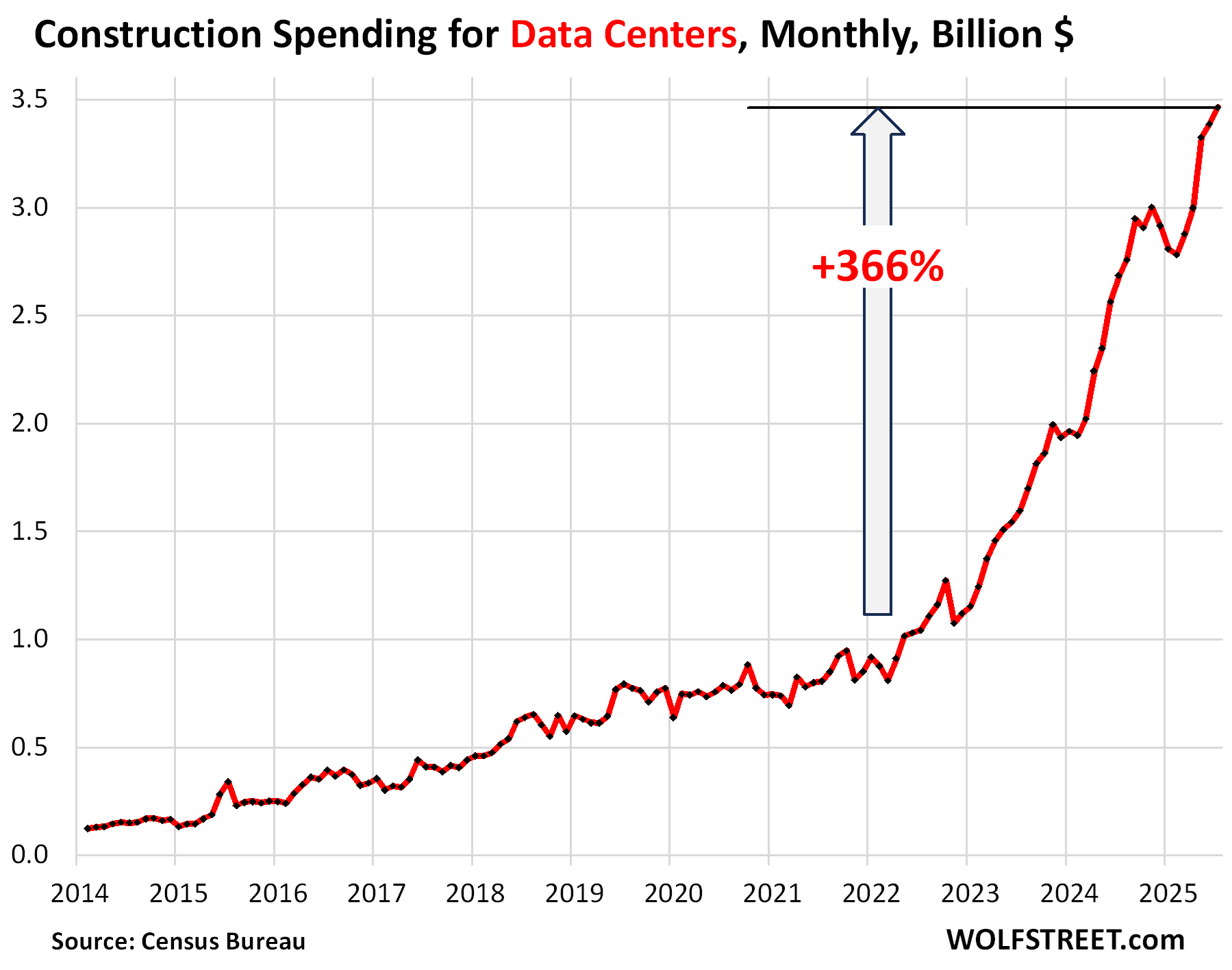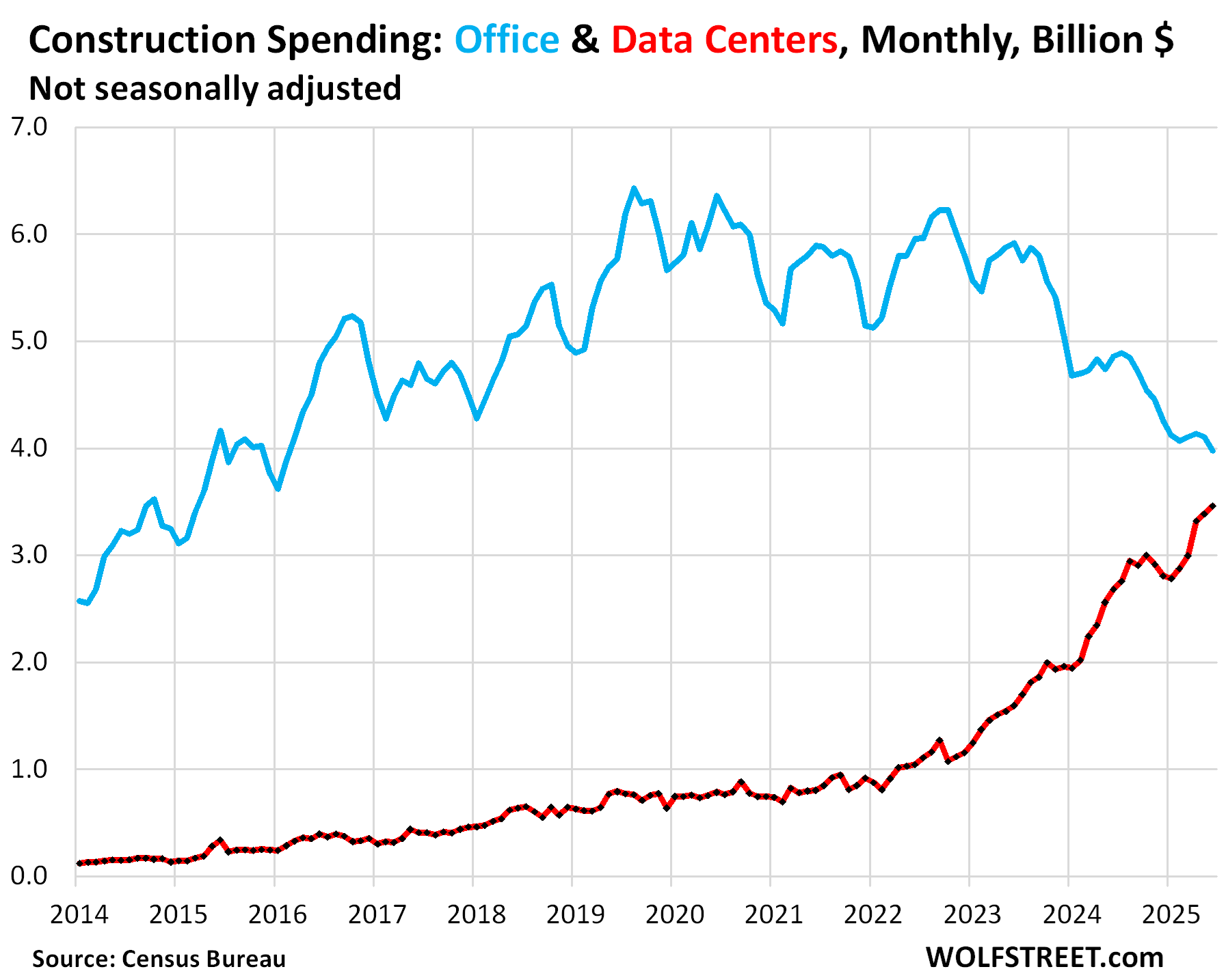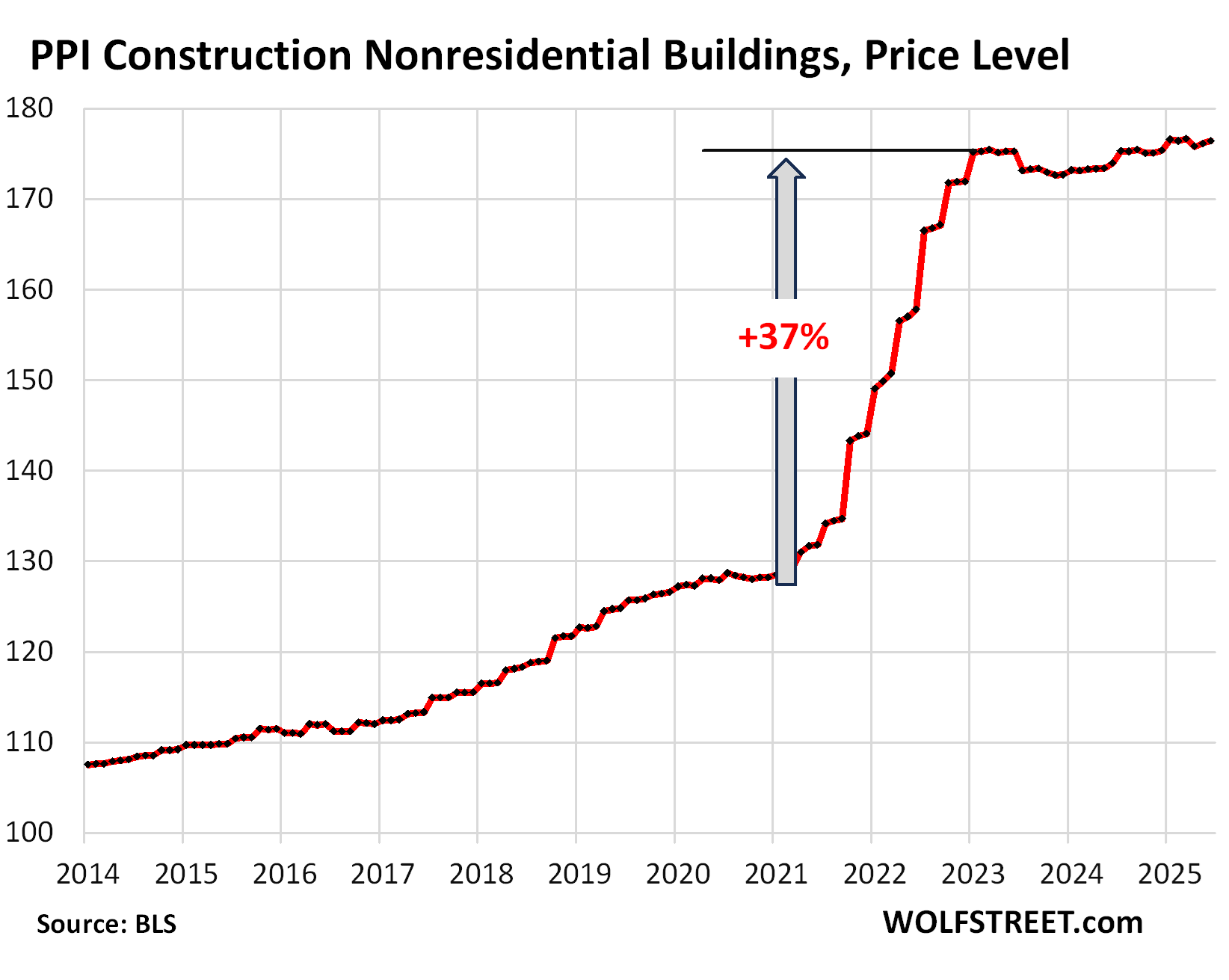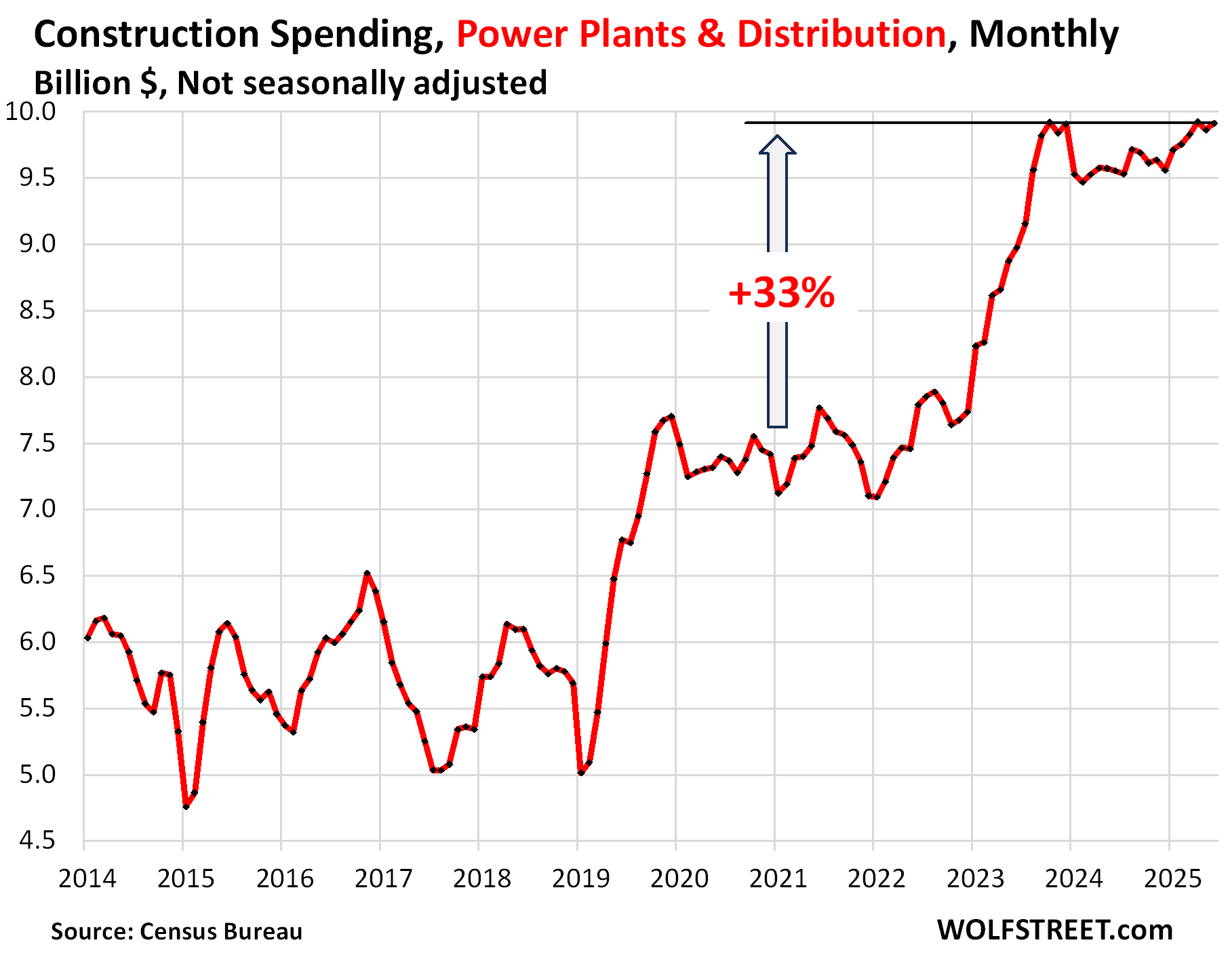Boom, bust, and the adults in the room.
By Wolf Richter for WOLF STREET.
Investments in the construction of data centers in the US has exploded. But this construction spending on data centers does not include the amounts spent on AI-specialized semiconductors, memory chips, servers, networking equipment, etc., which has reached astronomical levels. The four biggest cash-richest companies – Microsoft, Alphabet, Meta, and Apple – project capital expenditures of over $210 billion in their current fiscal years, just those four. Compared to that, construction costs are mundane. But they show the trend.
Construction spending on data centers soared by 29% year-over-year to $3.5 billion in June, not seasonally adjusted, up by 366% since the beginning of 2022, and up by 430% in the seven years since mid-2018. The $1-billion-a-month mark was surpassed for the first time in May 2022.

Data center construction had already grown at a red-hot pace before 2022, but 2022 triggered panic mode when Microsoft, Alphabet, Meta, and Apple, plus lots of lesser companies such as Tesla, plus data-center specialists such as Digital Realty, Equinix, and CoreSite, a subsidiary of American Tower, plus PE firms, VC firms, and hedge funds, plus everyone and their dog began throwing mindboggling amounts of cash at the physical infrastructure for AI, including the buildings to house the servers.
The Census Bureau, which tracks construction spending of all kinds, considers data-center construction spending one of the main segments of office construction spending.
The rest of office construction spending (total office minus data centers, blue in the chart below) has plunged since 2022 when the commercial real estate sector of office began to spiral into a depression.
In dollar terms, the rest of office construction spending has plunged nearly as much as data center construction spending has soared. As a result, total office construction spending, including data centers, has increased by only 17% since 2022 and by 30% since mid-2018.

Construction-cost increases: The PPI for Construction of Nonresidential Buildings jumped by 37% in two years from the beginning of 2021 through the end of 2022.
But construction cost inflation has stabilized in 2023 (actually negative inflation), 2024, and so far in 2025, and neither the data center construction boom nor the plunge in office construction over those years was significantly impacted by inflation.

Where’s the juice going to come from? Data centers require lots of power, and utilities or the data center providers themselves have to invest to build new capacity to generate this power and invest in the transmission infrastructure to get the power to the data centers. But it’s a slow complex process and takes many years.
And utilities want to make sure the infrastructure they plow billions of dollars into will not become a stranded asset when the AI bubble implodes, and so they’re proceeding with the care of the adults in the room.
Monthly construction spending on electric power installations, including power plants and transmission infrastructure, has run at a pace of $9 billion to $10 billion a month over the past two years ($9.6 billion in June), after two big waves of acceleration, totaling 67% since mid-2018. Since the beginning of 2021, the monthly construction pace has risen by 33%, essentially just tracking construction cost increases.
There are now numerous powerplant projects being planned and argued over, but they won’t show up in construction spending until on-site construction actually starts.

Enjoy reading WOLF STREET and want to support it? You can donate. I appreciate it immensely. Click on the mug to find out how:
![]()


Curios Wolf, how is construction in manufacturing plants doing after the huge rise the last few years? Are manufacturer’s repurposing present plants to accommodate the return of manufacturing to the U.S.? The U.S. doesn’t import much electric energy، geography and the Canadian border play a part in New England and the far northwest. Did any of the tariffs include electric energy?
I’m going to cover this in detail next month — including what’s driving it… got a new chart for that. Meanwhile, overall factory construction, not seasonally adjusted:
A single penny spent on Artificial Idiocy (AI) is just a penny wasted.
I don’t know what will happen in the future, but right now, I find “AI” to be a very useful tool for my work.
My healthcare organization uses AI all the time, such as for interpreting diagnostic results (with a doctor looking over its shoulder) and doing visit summaries, all of which then are posted online to where I can look at this stuff. Looks like they’re using AI to allow doctors to spend more time with patients, rather than doing this stuff.
You probably said the same thing about the internet and the cell phone!
Thanks to the demand from data centers, COMED just raised our rates 10% in Illinois.
Yes, that’s going to be a universal issue: lots of inflation in household electricity (adding to services inflation). Our power bill is already out the wazoo.
Not a fan of COMED for sure, and the increase stings, but they just deliver. Had something to do with the cost of power at the auctions last year. Should push nuclear power again. Fleet in the nation aging…
The Battery Electric Storage Systems (BESS) are popping up everywhere now. Stores huge amount of electricity – buys it cheap at night and sells it at top rates during the day. Ones in Canada will make over $1 B in gross income each. They are “powering” AI in a lot of data centres. Just huge growing industry. Unfortunately most of the batteries and the inverters are made in China
The amount of energy resources used for this AI destruction of our future is absurd:
In 2023, Google’s global data centers consumed approximately 6.1 billion gallons of potable water. This is equivalent to the amount of water needed to irrigate 41 golf courses in the southwestern US, according to Quartz. Two year old data, how quaint.
The increased trend of bed rotting, where one lays in bed all day surfing, will surely require greater data center capacity and investment — if only there was a way to accelerate the advancement of neural implants, so we can store our brains offsite and stop worrying about our mortal coils (and beds).
LOL, what hilarious comparison to point out wastefulness: Google’s data centers v. irrigating 41 golf courses in the southwestern US.
There is a Data Center that is in the planning stages near my cousin’s farm near Toronto, South Dakota. It is to encompass 1.8 million square feet. The name of the company is Applied Digital.
There’s a big one under way in Tucson, AZ slated to consume 5 million gallons of water/day. Good plan for a desert region that gets 11 inches of rain/year. It will produce 180 new full time jobs. In anticipation of this windfall, Tucson Electric Power has applied for a 14% rate increase.
Apple –> Amazon in a couple of paragraphs above?
Lots of hype for data centers in Norway too.
Local politicians are baited with promises of job creation, which doesn’t even seem close to realistic numbers, judging by the few completed projects.
Then centers are built on farmland, drives electricity prices through the roof and threatens the traditional heavy industry – which was made possible by cheap surplus electricity from our hydro plants in the first place.
So now the windmill industry is making a killing, supported by generous government subsidies – which they then reinvest to destroy nature wherever there is wind, baiting local politicians with job creation.
As the people that used to have good jobs in heavy industri are now unemployed, the pressure against local politicians to create jobs is now immense.
Happy days.